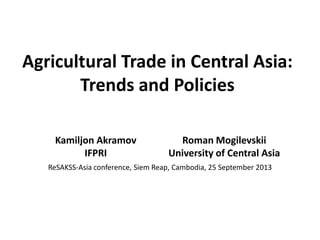
Agricultural Trade in Central Asia: Trends and Policies- Roman Mogilevskii and Kamiljon Akramov
- 1. Agricultural Trade in Central Asia: Trends and Policies Kamiljon Akramov IFPRI Roman Mogilevskii University of Central Asia ReSAKSS-Asia conference, Siem Reap, Cambodia, 25 September 2013
- 2. Contents • The role of trade in food supply • Trends in agricultural trade in Central Asia • Agriculture-related trade policies • Recent and anticipated policy changes and their impact on agricultural trade
- 3. Trade and Food Supply • Agriculture is export-oriented in Uzbekistan and Kazakhstan and much less so in Kyrgyzstan and Tajikistan • Imports of food are very important in all countries but Uzbekistan 21% 7% 8% 32% 28% 23% 19% 9% 0% 5% 10% 15% 20% 25% 30% 35% Kazakhstan Kyrgyzstan Tajikistan Uzbekistan %oftotaloutputofagriculture andfoodindustry Contributionof trade intosupply of and demandfor agricultural products andfood Agrifood exports Agrifood imports
- 4. Trade and Food Supply (2) • Kyrgyzstan and Tajikistan are critically dependent on imports of staple food 0% 20% 40% 60% 80% 100% Supply Demand Supply Demand Kyrgyzstan Tajikistan Grain balance, 2012 Domestic production Imports Domestic consumption Exports
- 5. Trends in Agricultural Trade 0% 3% 6% 9% 12% 0.0 0.6 1.2 1.8 2.4 3.0 3.6 4.2 4.8 2000 2012 2000 2012 Exports Imports BillionUSD Kazakhstan Trade value (lhs) % of total exports/imports (rhs) % GDP (rhs) 0% 4% 8% 12% 16% 20% 0 200 400 600 800 1000 2000 2012 2000 2012 Exports Imports MillionUSD Kyrgyzstan Trade value (lhs) % of total exports/imports (rhs) % GDP (rhs) 0% 7% 14% 21% 0 250 500 750 2000 2011 2000 2011 Exports Imports MillionUSD Tajikistan Trade value (lhs) % of total exports/imports (rhs) % GDP (rhs) 0% 10% 20% 30% 40% 50% 0 800 1600 2400 3200 4000 2000 2010 2000 2010 Exports Imports MillionUSD Uzbekistan Trade value (lhs) % of total exports/imports (rhs) % GDP (rhs)
- 6. Trends in Agricultural Trade (2) • Agricultural trade has dramatically grown in all countries of the region for the last 10-12 years • Importance of agricultural exports declined everywhere but in Tajikistan • Share of agricultural imports in total imports has been almost constant in KAZ, KGZ and UZB and increased in TJK • Role of agricultural trade in the economies (% GDP) mostly declined/stagnated except imports in KAZ and TJK
- 7. Structure of Agricultural Exports • Key agricultural exports are wheat and flour (KAZ) and cotton (UZB) • Other important exports in the region are fruits and vegetables Grain and flour 71% Other products 29% Kazakhstan- Exports Dairy products 9% Vegetables 33% Fruits 21% Prepared foods 11% Cotton 12% Other products 14% Kyrgyzstan- Exports Vegetables 6% Fruits 12% Cotton 78% Other products 4% Tajikistan- Exports Vegetables 9% Fruits 22% Cotton 57% Inputsfor agriculture 6% Other products 6% Uzbekistan- Exports
- 8. Structure of Agricultural Imports • All countries import prepared foods, grain and flour (except KAZ), meat (!), and inputs/fertilizers (except UZB) Grain and flour 30% Prepared foods 33% Other products 37% Uzbekistan- Imports Meat 6% Grain and flour 41% Prepared foods 31% Other products 22% Tajikistan- Imports Meat 9% Grain and flour 17% Prepared foods 41% Inputsfor agriculture 8% Other products 25% Kyrgyzstan- Imports Meat 8% Dairy products 9% Vegetables 4% Fruits 11% Prepared foods 43% Inputsfor agriculture 6% Other products 19% Kazakhstan- Imports
- 9. Geography of Agricultural Trade • Central Asian countries are important partners to each other for agricultural trade (much more than for non-agri trade) 0% 20% 40% 60% 80% 100% Agri trade Non-agri trade Agri trade Non-agri trade Agri trade Non-agri trade Agri trade Non-agri trade Kazakhstan Kyrgyzstan Tajikistan Uzbekistan Exports CA neighbors Russia China EU Other countries 0% 20% 40% 60% 80% 100% Agri trade Non-agri trade Agri trade Non-agri trade Agri trade Non-agri trade Agri trade Non-agri trade Kazakhstan Kyrgyzstan Tajikistan Uzbekistan Imports CA neighbors Russia China EU Other countries • Russia is important partner for all countries of the region both for exports and imports • China and EU (very important for non- agri trade) are significant markets for cotton exports only
- 10. Agricultural Trade Policies in Central Asia • MFN tariffs are rather high • Free trade regime for each other, Russia and other FSU • Weighted tariffs are much lower due to concentration of agri trade on neighbors and Russia 0 5 10 15 20 Kazakhstan Kyrgyzstan Tajikistan Uzbekistan Tariifsfor agricultural goods Simple average MFN applied Trade weighted average
- 11. Agricultural Trade Policies in Central Asia (2) • Non-tariff measures are very important for regional agricultural trade • Sanitary and phytosanitary measures are used often, especially by Russia and Kazakhstan (after creation of the Customs Union of Belarus, Kazakhstan and Russia) • Borders between these countries are “thick” – border crossing is expensive, time-consuming and unpredictable • Informal trade in agricultural goods is widespread, traders look for and find bypass routes to avoid formal trade restrictions • Re-export schemes (e.g. UZB→KGZ→KAZ for fertilizers or RUS→KGZ→TJK for gasoline) are used frequently
- 12. Policy Changes in Central Asia • Changes: creation of the Customs Union (CU) of BKR and WTO accession of Russia, Tajikistan • Expected WTO accession of Kazakhstan • Expected CU accession of Kyrgyzstan and, later, Tajikistan • No significant impact of the CU creation on agricultural trade in Kazakhstan and other CA countries • Complicated assessment of possible CU accession of Kyrgyzstan due to informality of key economic activities • Gains – better access to major markets for KGZ agricultural and food products (conditionally SPS issues addressed) • Losses – reduction in re-export business with implications for population incomes, consumer prices • Unclear prospects for labor migration – key issue also for Tajikistan
